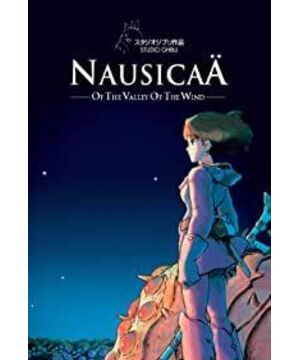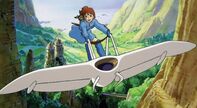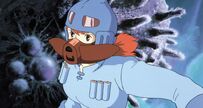Three years later, when I thought of this film by chance, I turned it out to watch it again, and I was still filled with emotion and emotion.
Hayao Miyazaki's films always have a soul-stirring aura. This is not due to the exquisite and gorgeous pictures in his works, but the spirit and ideas embodied in his films.
Sometimes, he starts from the big picture, and from the perspective of all mankind, he depicts the harmony between man and nature, and describes the cruelty of war. At this time, he always relied on his rich imagination and strong creativity to depict a new world, such as "City in the Sky", "Princess Mononoke", and this film.
Sometimes, he starts from the subtle, with the experience of a small person, to embody a spirit, or become a microcosm of an era. This person is either a commoner or a student, ordinary, but can resonate with countless people, such as "Goodbye Firefly", such as "The Fairy Tale of Time".
While watching Nausicaa, I almost cried several times. I never like to cry, but watching the plot in the film, I can't help but feel the pain.
The first time was the words that the protagonist Nausicaa said when she showed her underground laboratory to the teacher: "I found that if cultivated with clean water and soil, even these highly poisonous plants would not produce poisonous gas. Who is it that polluted the earth?"
Obviously, this is a critique of the destruction of nature by human industrial civilization.
The second time is the cry of the protagonist under the sea of rot. She said: "I cried because of joy. It turns out that the sea of rot is purifying this world polluted by human beings." This is another condemnation of human beings. The poisonous gas in the rotten sea is deadly to human beings, but they are purifying the world. Are humans just going to perish?
And the last time, it was the scene where I almost cried. The protagonist Nausicaa, in order to protect her hometown and to appease the anger of the king swarm, stood alone in front of the swarm, and decided to use her own life to redeem mankind's fault. Eventually the swarm forgives the humans, surrounds Nausicaa, and lifts it up with golden tentacles to heal. After Nausicaa woke up, the scene of walking on the golden tentacles was exactly as described in the prophecy: he was dressed in a blue long coat and floated down on the golden grassland. This means that human beings have finally found the only way to survive: to live in harmony with nature.
Here's another detail, which I only noticed when I looked at it for the second time: Nausicaa's clothes were red before, and the "blue gown" at the back was bloodied when she rescued the larvae of the king bug. Dyed blue.
My understanding is that the prophecy is entirely a symbolic meaning, whether the blue long coat or the golden grassland are derived from the body of the king insect and are symbols of nature.
A king bug is a wonderful creature. They are ugly and irritable, yet their golden tentacles are beautiful, and they are the guardians of nature.
In fact, everything is like this, and it has two sides. So do humans, and so do industries. The behavior of human beings to develop industry is not only improving conditions, but also digging their own graves. Fortunately, in recent years, the concept of sustainable development has been deeply rooted in the hearts of the people, and green and environmental protection have developed all over the world. But I still have to sigh, how wonderful is Hayao Miyazaki, who made this kind of work more than 20 years ago?
And after watching this film, I have only one thought: if human beings want to survive, they must Learn to live in harmony with nature.
Humans, after all, come from nature.
View more about Nausicaä of the Valley of the Wind reviews











